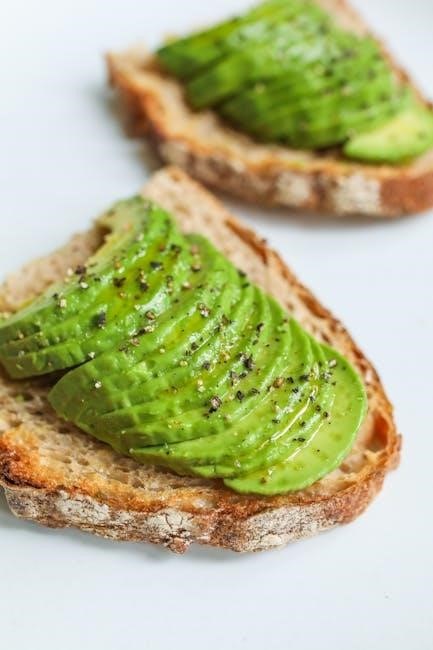Carb cycling involves alternating high-carb and low-carb days to optimize fat loss and muscle maintenance. It boosts metabolism, enhances recovery, and prevents plateaus, making it a popular diet strategy.
What is Carb Cycling?
Carb cycling is a dietary approach that alternates between high-carb and low-carb days to optimize fat loss and muscle preservation. By strategically timing carbohydrate intake, it boosts metabolism, enhancing fat burning while maintaining energy levels. This method prevents plateaus and supports physical performance. It involves eating simple carbs around workouts for quick fuel and recovery, while starchy carbs promote satiety and blood sugar balance. Tracking portions ensures adherence to the plan, making it effective for those seeking structured fat loss strategies.
Why Carb Cycling is Effective for Fat Loss
Carb cycling is effective for fat loss as it manipulates carbohydrate intake to deplete and replenish glycogen stores, enhancing the body’s ability to burn fat. By alternating high-carb and low-carb days, it creates a metabolic shift, increasing fat oxidation during low-carb phases. This approach prevents metabolic slowdowns, common in traditional diets, and maintains muscle mass. Additionally, it aligns carbohydrate intake with workout timing, optimizing energy use and recovery, making it a sustainable and efficient strategy for achieving fat loss goals while preserving lean tissue.

Benefits of a 12-Week Carb Cycling Meal Plan
A 12-week carb cycling plan offers structured fat loss, improved metabolic health, and sustained energy levels, helping dieters achieve their goals effectively and consistently over time.
Enhanced Fat Loss
Carb cycling accelerates fat loss by manipulating carbohydrate intake, creating a calorie deficit on low-carb days while maintaining high energy levels for workouts. This approach prevents metabolic slowdown, as high-carb days boost metabolism and replenish glycogen stores, optimizing fat burning. Additionally, it reduces cravings and promotes adherence, making it easier to stick to the diet long-term. The structured alternation ensures consistent progress without plateauing, helping individuals achieve significant fat loss over the 12-week period.
Muscle Preservation
Carb cycling helps preserve muscle mass during fat loss by ensuring adequate carbohydrate intake on high-carb days, which supports muscle recovery and growth. This prevents muscle breakdown, often seen in low-carb diets. By maintaining muscle, individuals retain metabolic activity, further enhancing fat loss. The balance of carbs and protein protects muscle tissue, making it easier to sustain long-term progress without sacrificing muscle definition. This approach is particularly effective for athletes and fitness enthusiasts aiming to maintain strength and physique while shedding fat.
Carb cycling enhances metabolic health by stabilizing blood sugar levels and improving insulin sensitivity. High-carb days replenish glycogen stores, while low-carb days promote fat utilization, balancing energy sources. This alternating approach reduces insulin spikes, lowering the risk of type 2 diabetes and metabolic syndrome. Better blood sugar control and efficient fat burning contribute to overall metabolic function, supporting long-term health and weight management. This balanced strategy helps maintain a healthy metabolism, crucial for sustained fat loss and energy levels. Carb cycling manipulates carbohydrate intake to maximize fat loss and muscle growth. It alternates between high-carb days for energy and low-carb days for fat burning, optimizing metabolism and performance. Balancing macronutrients is crucial for carb cycling success. On high-carb days, focus on complex carbs like whole grains and starches, paired with lean proteins and healthy fats. Timing is key; consume simple carbs before and after workouts for energy and recovery. Low-carb days emphasize protein and fats to maintain satiety and support fat loss. Proper timing ensures your body uses carbs efficiently, avoiding excess storage and promoting a metabolic balance that supports your fitness goals throughout the 12-week plan. High-carb days focus on replenishing glycogen stores, enhancing workout performance, and promoting recovery. They include starchy carbs like rice and potatoes, along with fiber-rich options. Low-carb days prioritize fat loss, reducing carb intake to force the body to burn fat for fuel. Protein and healthy fats are emphasized to maintain muscle and satisfaction. The alternation between these days creates a metabolic shift, optimizing both energy use and fat burning, which is essential for the 12-week plan’s effectiveness. Proper carb timing maximizes workout performance and recovery by fueling muscles when needed most, preventing fatigue, and supporting muscle growth while minimizing fat storage. Consuming simple carbs before and after workouts provides quick energy and aids recovery. Starchy carbs, like oats or whole grains, are ideal pre-workout for sustained energy, while post-workout, fast-digesting carbs like bananas or white rice help replenish glycogen stores. Pairing carbs with protein enhances muscle repair and growth. Timing carbs around workouts ensures optimal performance and recovery, supporting your fitness goals effectively. Carb intake is crucial for post-workout recovery, replenishing glycogen stores and supporting muscle repair. Consuming high-fiber carbs throughout the day aids blood sugar control and satiety, while simple carbs post-exercise accelerate recovery. Balancing starchy and high-fiber carbs ensures sustained energy and better overall recovery. This approach enhances muscle function and helps maintain metabolic health, making it essential for a successful 12-week carb cycling plan. Proper carb timing and selection are key to optimizing recovery and achieving fat loss goals effectively. A structured approach to alternating carb intake, balancing macronutrients, and timing meals around workouts to maximize fat loss and recovery while avoiding common diet pitfalls effectively. Establishing clear daily caloric and macronutrient targets is crucial for carb cycling success. Calculate your maintenance calories, then adjust for fat loss or muscle gain. Allocate carbs, protein, and fats based on high or low-carb days. On high-carb days, carbs make up 50-60% of calories, while protein remains steady at 25-30%. Low-carb days shift focus to fats and protein, ensuring adequate nutrition without excessive carb intake. This balance supports energy levels and recovery, preventing metabolic slowdowns and muscle loss during the cycle. On high-carb days, focus on whole, nutrient-dense foods. Breakfast options include oatmeal with berries and nuts or whole-grain toast with avocado and eggs. For lunch, consider quinoa salads, brown rice bowls, or whole-grain wraps with lean proteins. Dinner could feature sweet potato mash, roasted vegetables, and grilled chicken or fish. Snacks like fruit, yogurt, or whole-grain crackers with hummus are ideal. These meals provide sustained energy, support muscle recovery, and keep you satisfied, aligning perfectly with carb cycling goals.
The weekly structure alternates between high-carb and low-carb days, ensuring metabolic balance and preventing plateaus. This rotation supports fat loss while maintaining muscle mass effectively. Alternating high-carb and low-carb days keeps metabolism active, preventing plateaus. High-carb days fuel intense workouts and recovery, while low-carb days promote fat burning. This balance supports fat loss, preserves muscle, and improves metabolic health. Consistency is key to achieving long-term success in a 12-week plan. High-carb days provide energy for workouts, while low-carb days promote fat burning. This strategic alternation enhances fat loss and preserves muscle, optimizing overall metabolism. On high-carb days, focus on complex carbs like oats, brown rice, and whole grains. Include starchy vegetables such as sweet potatoes and carrots. Simple carbs like bananas and white rice are ideal pre- and post-workout for quick energy. Pair carbs with lean proteins and healthy fats to balance meals and support muscle recovery. Opt for whole, unprocessed foods to maintain steady blood sugar levels and maximize nutrient intake. This approach ensures sustained energy and optimal performance during training sessions. On low-carb days, prioritize protein-rich foods like chicken, fish, and eggs. Incorporate healthy fats such as avocados, nuts, and olive oil to keep you full. Non-starchy vegetables like spinach, broccoli, and cauliflower are ideal for adding fiber and nutrients without excess carbs. Avoid sugary snacks and opt for low-carb alternatives like cheese or hard-boiled eggs. This combination helps maintain satiety, supports fat loss, and ensures you stay within your daily carb limit while providing essential nutrients for overall health and performance. Stock up on lean proteins, healthy fats, and carb sources like brown rice, oats, and sweet potatoes. Include non-starchy vegetables and low-sugar snacks for balance. On high-carb days, focus on complex carbs like whole grains, legumes, and starchy vegetables such as sweet potatoes and oats. These provide sustained energy and fiber. Include lean proteins like chicken, fish, and eggs to support muscle growth. Healthy fats from avocados and nuts add satiety. Fresh fruits like berries and bananas offer quick energy. Pair these with non-starchy veggies like spinach and broccoli for balanced nutrition. Proper hydration is also crucial to maximize nutrient absorption and overall performance. Regularly monitor weight, measurements, and progress photos to gauge fat loss and muscle retention. Adjust carb cycling based on visible changes and how your body responds. Tracking weight, measurements, and progress photos is crucial for assessing fat loss and muscle retention. Take weekly photos and measurements to observe changes. Ensure consistent conditions for accuracy, such as the same time of day and lighting. Weight fluctuations may occur, so focus on trends over time; Note how clothes fit and energy levels improve. This data helps refine your carb cycling plan, ensuring adjustments align with your fat loss goals. Stay consistent for reliable results. Overeating on low-carb days and neglecting portion control are frequent errors. Stick to your macronutrient goals to achieve optimal fat loss without sabotaging progress. Overeating on low-carb days can hinder progress. Many mistake low-carb for unlimited, leading to calorie excess. Focus on protein and healthy fats to stay full. Avoid high-calorie snacks, as they negate fat loss efforts. Tracking intake ensures adherence to macronutrient goals. Portion control is key to maintaining a calorie deficit without compromising nutrition. Balanced meals prevent overconsumption, supporting sustained weight loss. Stay disciplined to achieve desired results. Carb cycling is a sustainable approach as it avoids extreme restrictions, allowing for a balanced lifestyle. This method supports long-term fat loss and overall well-being. Maintaining long-term fat loss requires consistency and flexibility. Carb cycling helps sustain results by balancing macronutrients and adapting to metabolic changes. Incorporating whole foods and mindful eating supports lasting weight management, ensuring the body continues to burn fat efficiently without extreme deprivation. Over time, this approach fosters a healthier relationship with food and exercise, making it easier to maintain progress beyond the initial 12-week period. A well-structured 12-week carb cycling meal plan can effectively boost fat loss and improve overall health. By alternating carb intake, individuals achieve sustainable results without extreme restrictions. Consistency is key to maximizing carb cycling benefits. Pair high-carb days with intense workouts and focus on nutrient-dense foods. Track progress weekly and adjust portions as needed. Avoid overeating on low-carb days to maintain calorie control. Stay hydrated and ensure adequate sleep for optimal recovery. Plan meals in advance to avoid deviations. Celebrate small milestones to stay motivated throughout the 12-week journey. A disciplined approach will yield sustainable fat loss and improved overall health.Improved Metabolic Health
How Carb Cycling Works
Macronutrient Balance and Timing
Difference Between High-Carb and Low-Carb Days

Importance of Carb Timing
Pre- and Post-Workout Nutrition
Optimizing Carb Intake for Recovery
Creating a 12-Week Carb Cycling Meal Plan
Setting Daily Caloric and Macronutrient Goals
Sample Meal Ideas for High-Carb Days

Weekly Structure of the Meal Plan
Alternating High-Carb and Low-Carb Days

High-Carb vs. Low-Carb Days
Food Choices for High-Carb Days
Food Choices for Low-Carb Days
Grocery List for Carb Cycling
Essential Foods for High-Carb Days

Tracking Progress
Monitoring Weight, Measurements, and Progress Photos
Common Mistakes to Avoid
Overeating on Low-Carb Days
Sustainability of Carb Cycling
Maintaining Long-Term Fat Loss
Final Tips for Success
